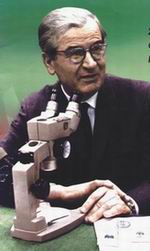| Revision as of 19:13, 3 April 2022 editFrancis Flinch (talk | contribs)Extended confirmed users36,173 editsm →Biography← Previous edit | Revision as of 13:25, 4 April 2022 edit undoAlpha Piscis Austrini (talk | contribs)Extended confirmed users17,629 editsm clean upTag: AWBNext edit → | ||
| Line 20: | Line 20: | ||
| ==Biography== | ==Biography== | ||
| Smakula was born to a peasant family in Dobrovody village, ] (today ], ]). After finishing his studies at the Ternopil gymnasium he applied to the ] from which he graduated in 1927. Afterwards he worked as an assistant of Prof. ]. After his short stay at ], Smakula returned to Germany as head of an optics laboratory in ]. From 1934 he worked at the ] company in ]. While at Zeiss, in 1935, Smakula invented and patented optical ]s, a significant advance in optical technology.<ref></ref> During World War II, he collaborated with the Nazi regime and worked on ] for missiles. After the end of World War II Smakula went to the US with other German physicists, where he first worked in Virginia investigating materials for infrared technology. In 1951 he was offered a professorship at ], where he mainly did research into crystalline materials. Olexander Smakula died on May 17, 1983, and is buried in ], ]. | Smakula was born to a peasant family in Dobrovody village, ] (today ], ]). After finishing his studies at the Ternopil gymnasium he applied to the ] from which he graduated in 1927. Afterwards he worked as an assistant of Prof. ]. After his short stay at ], Smakula returned to Germany as head of an optics laboratory in ]. From 1934 he worked at the ] company in ]. While at Zeiss, in 1935, Smakula invented and patented optical ]s, a significant advance in optical technology.<ref></ref> During World War II, he collaborated with the Nazi regime and worked on ] for missiles. After the end of World War II Smakula went to the US with other German physicists, where he first worked in Virginia investigating materials for infrared technology. In 1951 he was offered a professorship at ], where he mainly did research into crystalline materials. Olexander Smakula died on May 17, 1983, and is buried in ], ]. | ||
| ==References== | |||
| {{Reflist}} | |||
| ==External links== | ==External links== | ||
Revision as of 13:25, 4 April 2022
| Olexander Smakula | |
|---|---|
 | |
| Born | 1900 Dobrovody, Austria-Hungary (today Ukraine) |
| Died | 17 May 1983 Auburn, Massachusetts, USA |
| Alma mater | University of Göttingen |
| Known for | anti-reflective coating |
| Scientific career | |
| Fields | Physicist |
| Institutions | Odessa University Carl Zeiss AG Massachusetts Institute of Technology |
| Doctoral advisor | Robert Pohl |
Olexander Smakula (Template:Lang-uk) (1900 in Dobrovody, Austria-Hungary, today Ukraine – 17 May 1983 in Auburn, Massachusetts, USA), also described in English as Alexander Smakula, was a Ukrainian physicist known for the invention of anti-reflective lens coatings based on optical interference.
Biography
Smakula was born to a peasant family in Dobrovody village, Austria-Hungary (today Ternopil Oblast, Ukraine). After finishing his studies at the Ternopil gymnasium he applied to the University of Göttingen from which he graduated in 1927. Afterwards he worked as an assistant of Prof. Robert Pohl. After his short stay at Odessa University, Smakula returned to Germany as head of an optics laboratory in Heidelberg. From 1934 he worked at the Carl Zeiss AG company in Jena. While at Zeiss, in 1935, Smakula invented and patented optical anti-reflective coatings, a significant advance in optical technology. During World War II, he collaborated with the Nazi regime and worked on infrared guidance for missiles. After the end of World War II Smakula went to the US with other German physicists, where he first worked in Virginia investigating materials for infrared technology. In 1951 he was offered a professorship at MIT, where he mainly did research into crystalline materials. Olexander Smakula died on May 17, 1983, and is buried in Auburn, Massachusetts, USA.
References
- History of Camera Lenses from Carl Zeiss — 1935 — Alexander Smakula develops anti-reflection coating
External links
- History of Camera Lenses from Carl Zeiss - 1935 - Alexander Smakula develops anti-reflection coating
- Lens coating invented and developed by Alexander Smakula
- Physicist Oleksandr Smakula and his contributions to science. Welcome to Ukraine 2008, 3.
- Encyclopedia Aeronautica about Smakula